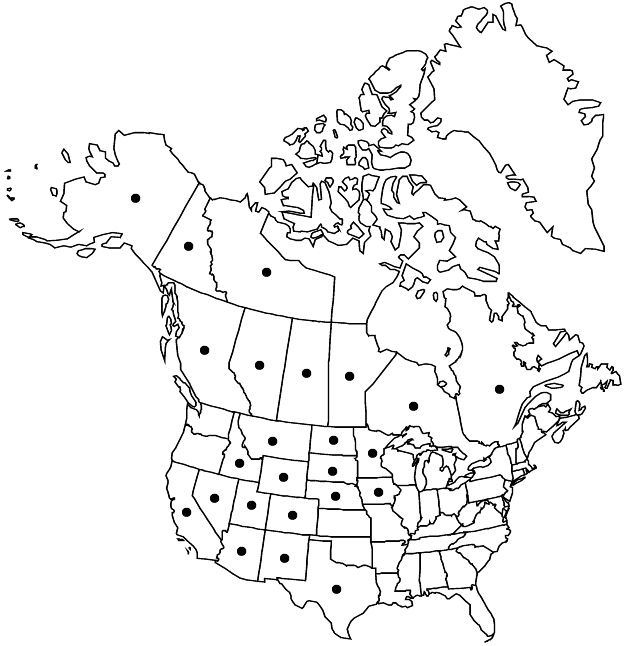Potentilla pensylvanica
Mant. Pl. 1: 76. 1767.
Stems ascending to erect, (0.3–) 1–4 (–6) dm. Basal leaves pinnate, (2–) 4–20 (–25) cm; petiole 1–8 cm, long hairs sparse to abundant, rarely absent, spreading to ascending, 0.5–3 mm, weak to ± stiff, short hairs abundant to dense, rarely absent, cottony or crisped hairs absent, glands sparse to abundant, often obscured; leaflets (2–) 3–5 (–7) per side, on distal 1/2–3/5 of leaf axis, separate to scarcely overlapping, terminal ones narrowly to broadly oblanceolate, (1–) 1.5–5 (–6) × 0.5–1.5 (–2) cm, margins strongly revolute, incised ± 3/4 to midvein, sometimes more or only ± 1/2, undivided medial blade 2–4 (–8) mm wide, teeth 4–8 (–10) per side, triangular-ovate to linear-elliptic, surfaces usually ± dissimilar, abaxial ± grayish to nearly white, rarely green, long hairs sparse to abundant (mostly on veins), rarely absent, 0.5–1.5 mm, ± weak, short hairs usually abundant to dense, rarely absent, crisped and cottony hairs absent, glands ± abundant, sometimes obscured, adaxial green to gray-green, long hairs sparse to abundant, rarely absent, spreading to ascending, ± 1 mm, short hairs ± abundant, sometimes obscured, rarely absent, cottony and crisped hairs absent, glands ± abundant. Cauline leaves 1–4. Inflorescences (1–) 3–40-flowered, congested or elongating in fruit. Pedicels 0.2–1 cm (proximal to 3.5 cm). Flowers: epicalyx bractlets usually ± lanceolate-elliptic, rarely ± ovate-elliptic, 3–6 (–8) × (1–) 1.5–2 (–2.5) mm, lengths ± equal to sepals, margins ± revolute; hypanthium 3–6 mm diam.; sepals (3–) 4–6 (–8) mm, apex acute to obtuse, abaxial surfaces: venation indistinct, glands abundant, ± evident; petals pale to bright-yellow, (3–) 4–7 × (3–) 4–7 mm, lengths ± equal to sepals; filaments (0.5–) 1–2 mm, anthers 0.5–0.8 (–1) mm; carpels 50–100, styles papillate-swollen in proximal ± 1/2, ± 1 mm. Achenes 1.2 mm, ± to strongly rugose. 2n = 28.
Phenology: Flowering summer.
Habitat: Open prairies, steppe bluffs, shallow gravelly soil, rocky ridges and outcrops, dry stream channels, similar disturbed sites
Elevation: 100–4000 m
Distribution

Alta., B.C., Man., N.W.T., Ont., Que., Sask., Yukon, Alaska, Ariz., Calif., Colo., Idaho, Iowa, Minn., Mont., Nebr., Nev., N.Mex., N.Dak., S.Dak., Tex., Utah, Wyo., Mexico (Tamaulipas), Eurasia
Discussion
Even in the reduced circumscription used here, Potentilla pensylvanica is exceptionally widespread, occurring in North America from Alaska to Hudson Bay, in the Great Plains and the North American Cordillera to northern Mexico. The species also grows across Siberia (where it has sometimes been called P. sibirica) and as isolated occurrences in the southwestern Alps and Spain (J. Soják 1987c; A. Kurtto et al. in J. Jalas et al. 1972+, vol. 13). One place P. pensylvanica does not occur is in Pennsylvania; the epithet was applied by Linnaeus to cultivated plants originating from Canada. Collections from Quebec are probably introductions (J. Cayouette, pers. comm.). The Oregon citation of P. pensylvanica (D. Mansfield 2000) refers to P. jepsonii.
Significant variation occurs within Potentilla pensylvanica, especially regarding vestiture and plant stature. J. Soják (1987c) has described several varieties, all Eurasian except var. brevipila (long hairs 0.6–1 mm); diminutive specimens from the Brooks Range of northern Alaska, isolated from other known populations of P. pensylvanica, have been described as P. brooksensis. Although much of the ecogeographic variation may merit recognition, at least at varietal level, doing so is postponed pending further analysis and clarification of nomenclature. Among the extremes are plants from the Great Plains, which have abundant long silky hairs overlying and obscuring the velvety layer of short hairs (resembling sympatric P. litoralis), and glabrate (except for glands) populations in Alaska. E. Hultén (1968) erroneously referred to the latter as P. pensylvanica var. glabrata (Lehmann) S. Watson; that name is a synonym of P. ovina var. ovina (sect. Multijugae). Most populations in Alaska also have larger than average flowers (petals to 7 × 7 mm, anthers ca. 1 mm).
Although Potentilla pensylvanica var. strigosa Pursh has been one of the most commonly used varieties in North America, the name has been effectively lectotypified by J. Soják (1987c) on a collection from Siberia. Soják identified this collection as the hybrid between P. pensylvanica and the Asian P. sanguisorba D. F. K. Schlechtendal; var. strigosa accordingly does not occur in North America.
Selected References
None.
Lower Taxa
"thin" is not a number."elongating" is not a number."dm" is not declared as a valid unit of measurement for this property."(" is not declared as a valid unit of measurement for this property."dm" is not declared as a valid unit of measurement for this property."dm" is not declared as a valid unit of measurement for this property.
